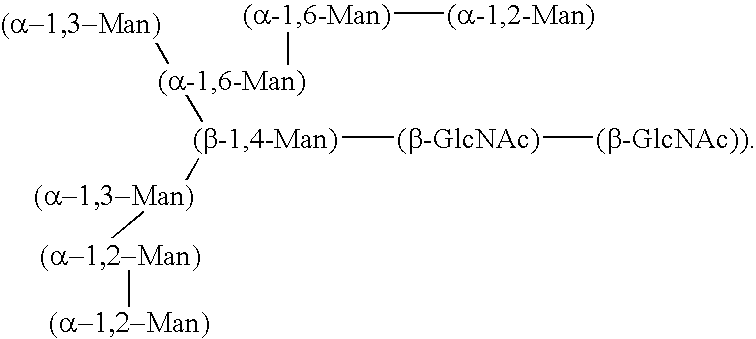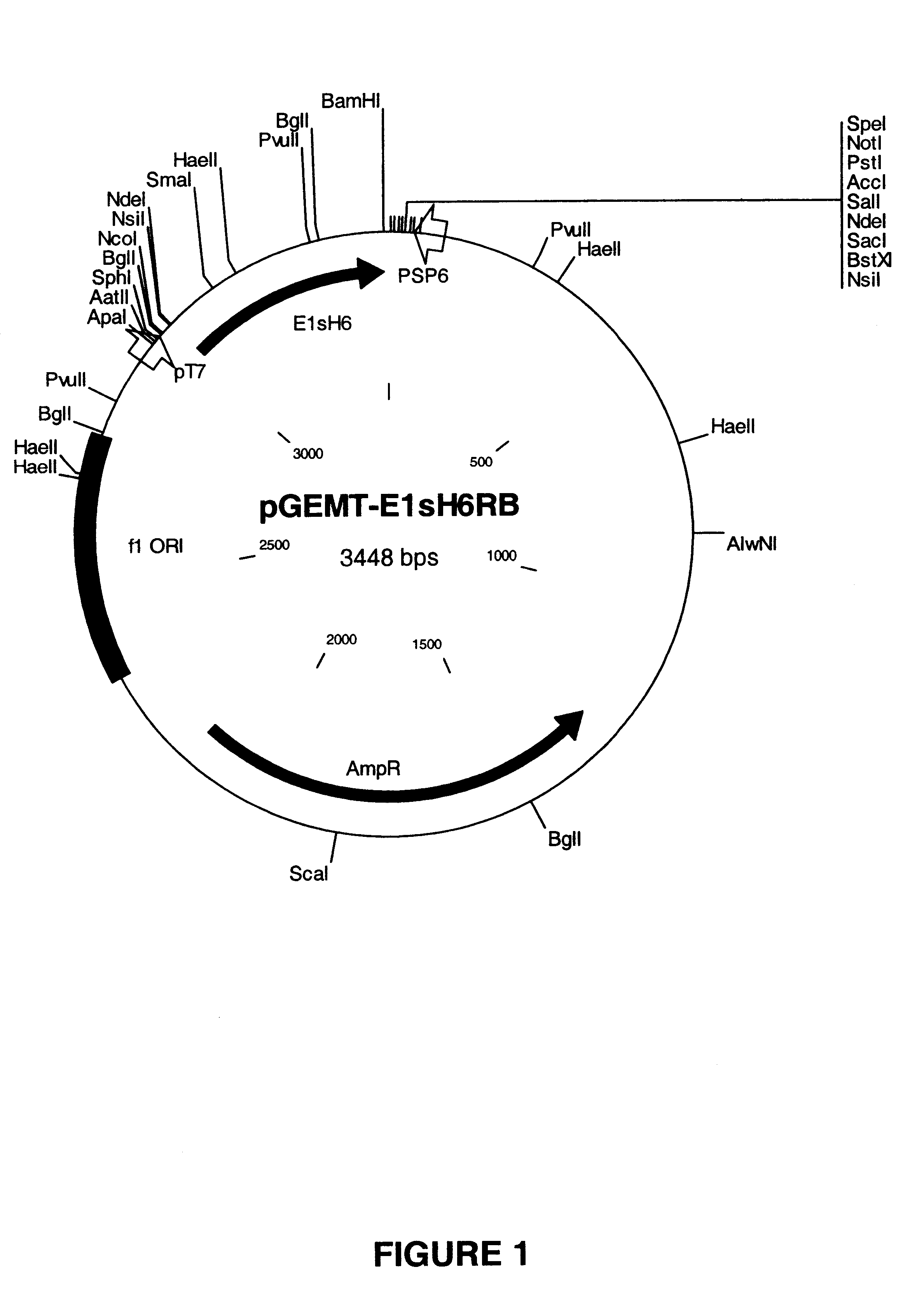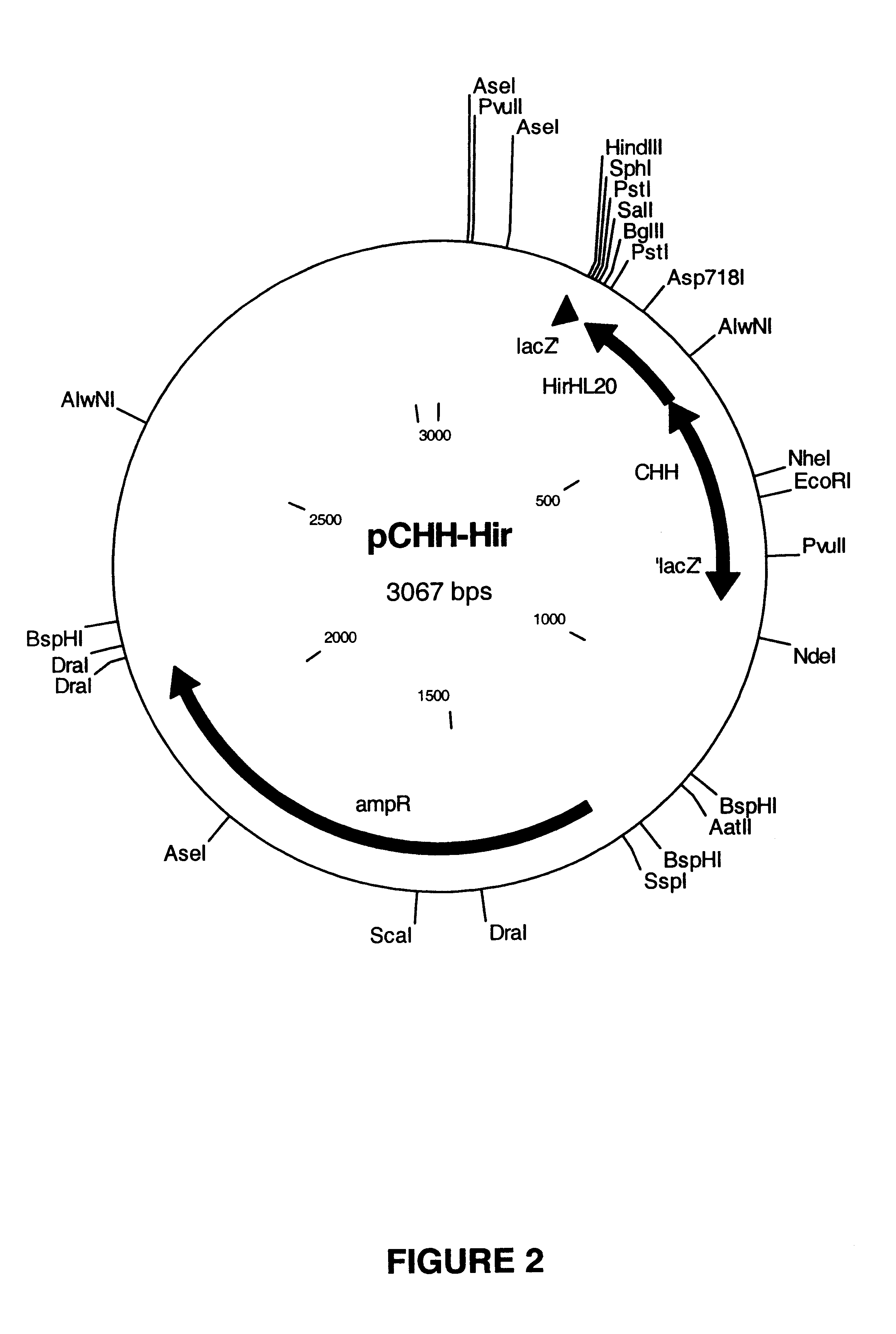Expression of core-glycosylated HCV envelope proteins in yeast
a technology of hcv envelope and core glycosylation, which is applied in the field of expression of core glycosylated hcv envelope proteins in yeast, can solve the problems of impaired production of large amounts of correctly glycosylated hcv envelope proteins, and the failure of native anti-hcv antibodies to recognize an important subset of antigenic determinants of these proteins
- Summary
- Abstract
- Description
- Claims
- Application Information
AI Technical Summary
Benefits of technology
Problems solved by technology
Method used
Image
Examples
example 1
Construction of pFPMT-MFα-E1-H6 Shuttle Vector
[0221]Plasmids for Hansenula polymorpha transformation were constructed as follows. The pFPMT-MFα-E1-H6 shuttle vector has been constructed in a multi-step procedure. Intially the nucleic acid sequence encoding the HCV E1s protein (SEQ ID NO:2) was cloned after a CHH leader sequence (CHH=Carcinus maenas hyperglycemic hormone) which was subsequently changed for a MFα leader sequence (MFα=Saccharomyces cerevisiae α-mating factor).
[0222]At first a pUC18 derivative has been constructed harboring the CHH-E1-H6 unit as a EcoRI / BamHI fragment by the seamless cloning method (Padgett, K. A. and Sorge, J. A. 1996). Thereto, the E1s-H6-encoding DNA fragment and the pCHH-Hir-derived acceptor plasmid were generated by PCR as described below.
Generation of E1s-H6-encoding DNA Fragment
[0223]The E1-H6 DNA fragment (coding for HCV type 1b E1s protein consisting of the amino acids 192 to 326 of E1s elongated with 6 His-residues; SEQ ID NO:5) was isolated b...
example 2
Construction of pFPMT-CL-E1-H6 Shuttle Vector
[0263]Plasmids for Hansenula polymorpha transformation were constructed as follows. The pFPMT-CL-E1-H6 shuttle vector was constructed in three steps starting from pFPMT-MFα-E1-H6 (SEQ ID NO:16, FIG. 5).
[0264]In a first step, the MFα-E1-H6 reading frame of pFPMT-MFα-E1-H6 was subcloned into the pUC18 vector. Therefore a 1.798 kb SalI / BamHI fragment of pFPMT-MFα-E1-H6 (containing the FMD promotor plus MFα-E1-H6) was ligated to the SalI / BamHI vector fragment of pUC18 with T4 ligase (Boehringer) accordig to the supplier's conditions. This resulted in plasmid that is depicted in FIG. 6 (SEQ ID NO:17), and further denominated as pMa12-1 (pUC18-FMD-MFα-E1-H6). The ligation mixture was used to transform E. coli DH5αF′ cells. Several ampicillin-resistant colonies were picked and analyzed by restriction enzyme digestion of plasmid DNA isolated from the picked clones. A positive clone was further analyzed by determining the DNA sequence of the MFα-E...
example 3
Construction of pFPMT-MFα-E2-H6 and pMPT-MFα-E2-H6 Shuttle Vectors
[0278]Plasmids for Hansenula polymorpha transformation were constructed as follows. The DNA sequence encoding the MFα-E2s (amino acids 384–673 of HCV E2)-VIEGR-His6 (SEQ ID NO:5) was isolated as a 1.331 kb EcoRI / BglII fragment from plasmid pSP72E2H6 (SEQ ID NO:22, FIG. 9). This fragment was ligated with either the EcoRI / BglII-digested vectors pFPMT121 (SEQ ID NO:12, FIG. C+2) or pMPT121 (SEQ ID NO:23, FIG. 10) using T4 DNA ligase (Boehringer Mannheim) according to the supplier's recommendations. After transformation of E. coli and checking of plasmid DNA isolated from different transformants by restriction enzyme digestion, positive clones were withheld and the resulting shuttle vectors are denominated pFPMT-MFα-E2-H6 (SEQ ID NO:22, FIG. 11) and pMPT-MFα-E2-H6 (SEQ ID NO:23, FIG. 12), respectively.
PUM
| Property | Measurement | Unit |
|---|---|---|
| pH | aaaaa | aaaaa |
| molecular weight | aaaaa | aaaaa |
| molecular weight | aaaaa | aaaaa |
Abstract
Description
Claims
Application Information
 Login to View More
Login to View More - R&D
- Intellectual Property
- Life Sciences
- Materials
- Tech Scout
- Unparalleled Data Quality
- Higher Quality Content
- 60% Fewer Hallucinations
Browse by: Latest US Patents, China's latest patents, Technical Efficacy Thesaurus, Application Domain, Technology Topic, Popular Technical Reports.
© 2025 PatSnap. All rights reserved.Legal|Privacy policy|Modern Slavery Act Transparency Statement|Sitemap|About US| Contact US: help@patsnap.com



